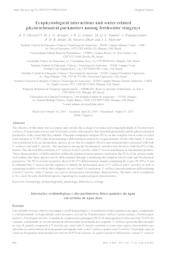Ecophysiological interactions and water-related physicochemical parameters among freshwater stingrays.
Ecophysiological interactions and water-related physicochemical parameters among freshwater stingrays.
Autoria: OLIVEIRA, A. T.; ARAÚJO, M. L. G.; LEMOS. J. R. G.; SANTOS, M. Q. C.; PANTOJA-LIMA, J.; ARIDE, P. H. R.; TAVARES-DIAS, M.; MARCON, J. L.
Resumo: The objective of this study was to compare and correlate the ecology of neonates and young individuals of Potamotrygon wallacei, Potamotrygon motoro and Paratrygon aiereba with regard to their hematological profile and the physicochemical parameters of the water that they inhabit. Principal component analysis (PCA) on the complete blood count revealed total variation of 72.92%, thus demonstrating a differentiation system for oxygen demand. On the other hand, P. motoro was considered to be an intermediate species, given that its complete blood count characteristics interacted with both P. wallacei and with P. aiereba. The interaction among the biochemical variables was shown to total 64.67% of the factors. This allowed differentiation of P. wallacei from P. aiereba, while P. motoro maintained an intermediate position. These characteristics of differentiation within the preferred environment corroborate the PCA of the present study and confirm that these species can be differentiated through considering the complete blood count and biochemical parameters. The PCA on water properties showed 68.57% differentiation, mainly comprising the x axis (49.44%). It can be affirmed that P. motoro has the capacity to inhabit the preferential areas of P. wallacei and P. aiereba, as well as occupying localities in which other stingrays are not found. In conclusion, P. wallacei presents patterns differentiating it from P. aiereba, while P. motoro is a species that presents intermediate characteristics. The latter can be considered to be a more broadly distributed species regarding its ecophysiological characteristics.
Ano de publicação: 2017
Tipo de publicação: Artigo de periódico
Unidade: Embrapa Amapa
Palavras-chave: Arraia, Ecologia animal, Fisiologia, Hematologia, Hematology, Potamotrygonids, animal ecology, physiology
Observações
1 - Por padrão são exibidas publicações dos últimos 20 anos. Para encontrar publicações mais antigas, configure o filtro ano de publicação, colocando o ano a partir do qual você deseja encontrar publicações. O filtro está na coluna da esquerda na busca acima.
2 - Para ler algumas publicações da Embrapa (apenas as que estão em formato ePub), é necessário ter, no celular ou computador, um desses softwares gratuitos. Sistemas Android: Google Play Livros; IOS: iBooks; Windows e Linux: software Calibre.
Acesse outras publicações
Acesse a Base de Dados da Pesquisa Agropecuária (BDPA) para consultar o acervo completo das bibliotecas da Embrapa.

